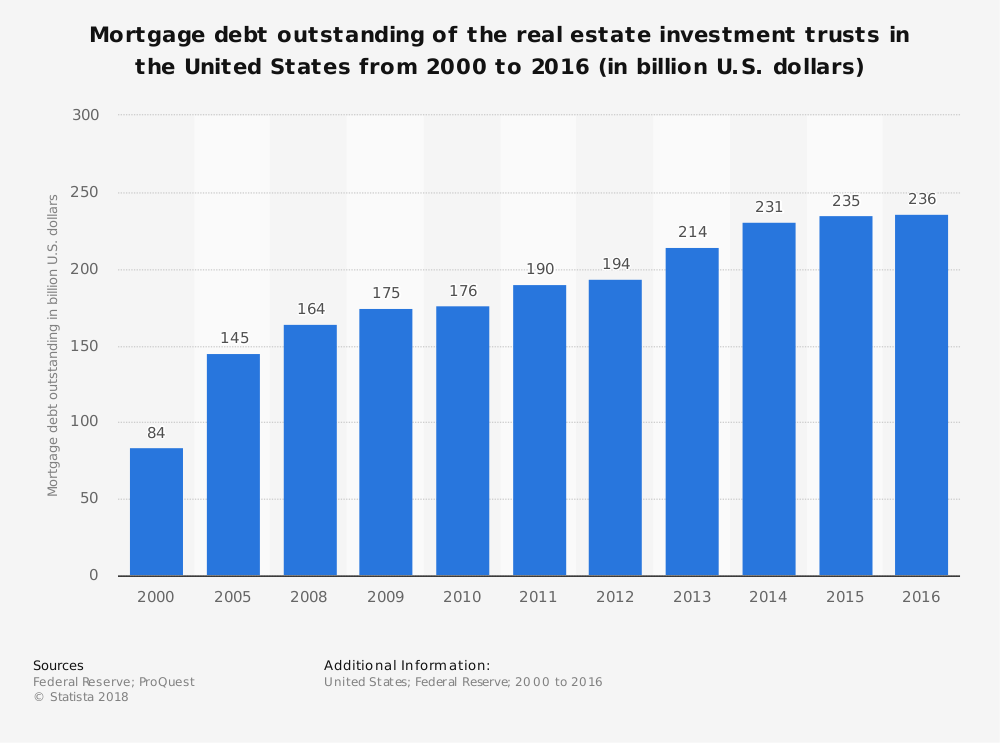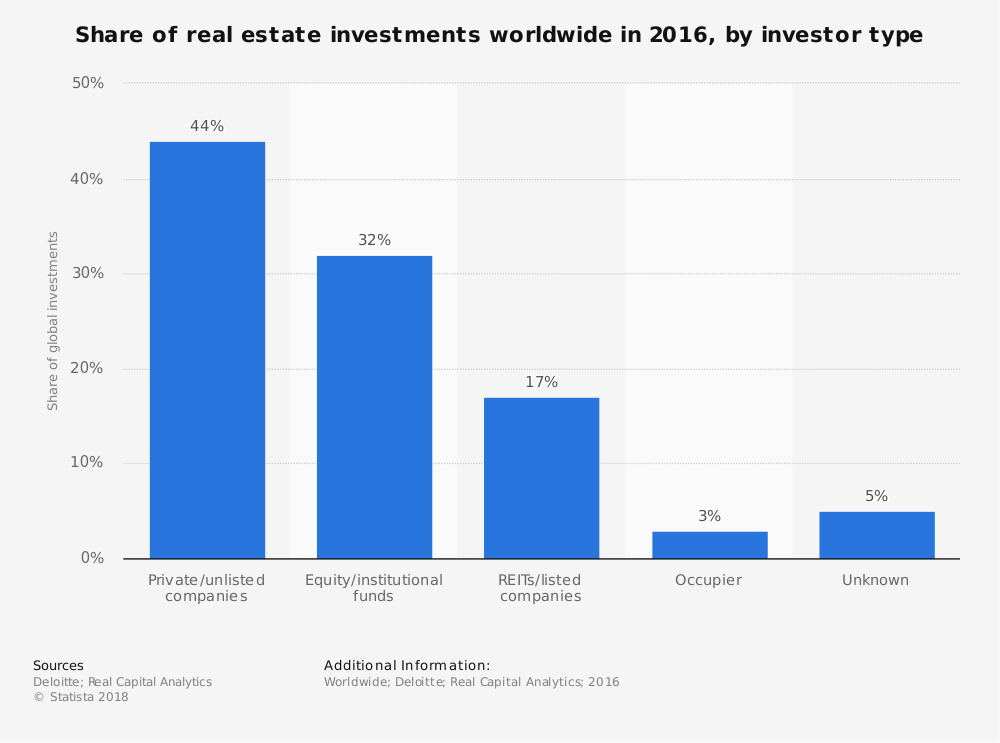REITs were first created in 1960 when Public Law 86-779 was signed by President Dwight D. Eisenhower. The first REIT, American Realty Trust, was founded in 1961. Since then, 30+ countries have established the legality of REITs as well.
The advantage of REITs is that they allow anyone to invest in portfolios of real estate assets like they could for any other industry. The most common vehicles for investment are mutual funds and exchange traded funds, or ETFs. Shareholders of a REIT then earn a share of the income being produced by the real estate investments without needing to own actual real estate to do so.
REITs are required to pay a minimum of 90% of their taxable income to shareholders. Most REITs will pay out 100%.
Important REIT Industry Statistics
#1. The current equity market capitalization of REITs listed on the New York Stock Exchange equals $955.8 billion. There are currently 191 REITs which currently trade on the NYSE. (Nareit)
#2. Listed REITs, which include mREITs and equity REITs, paid over $53 billion in dividends in 2017. Non-listed public REITs paid out over $4 billion in dividends in 2017 as well. (Nariet)

#3. About 76% of the annual dividends which are paid out by REITs qualify as regular taxable income. 14% of the annual dividends qualify as a long-term capital gain, while the remaining percentage qualify as a return of capital. (Nariet)
#4. In March 2008, the average daily dollar trading volume of REITs was $4.5 billion. In March 2018, the average daily dollar trading volume was $7.2 billion. (Nariet)
#5. In 2016, REITs generated over $119 billion in labor income, contributing the equivalency of 2 million full-time jobs to the economy in the United States. (The REIT Way)
#6. REITs own more than 200,000 properties in the United States. These properties represent more than $3 trillion in gross real estate assets under current valuation structures. (The REIT Way)
#7. In 2016, REITs, were responsible for almost $53 billion in new construction and routine expenditures while maintaining their existing properties. (The REIT Way)
#8. For the 5-year period ending in 2018, the annualized growth of real estate investment trusts in the United States is 4.7%. When all revenues generated by the industry are calculated, more than $96 billion is generated annually by the REITs industry. (The REIT Way)
#9. As of December 2017, the global REIT index included 477 companies, representing 35 countries, with a total equity market capitalization of around $2 trillion. 78% of this total comes from REITs. (Nareit)
#10. Since 2010, the U.S.-based REIT industry has seen a growth rate of 147%. If the United States is excluded from global figures, the REIT industry experienced a 100% increase in value between 2010-2016. (Ernst and Young Global)

#11. The United States accounts for two-thirds of global REIT market capitalization. With this category, $1.1 trillion of a total $1.7 trillion in REIT capitalization comes through mature funds. (Ernst and Young Global)
#12. In 2015, about $30 billion in equity was raised by REITs. In global markets, excluding the U.S., another $18 billion was raised. In comparison, 10 private equity real estate fund managers raised a collective $50 billion in 2015. (Ernst and Young Global)
#13. As of December 2015, 20 institutions own nearly $400 billion in common equity of US REITs. (Ernst and Young Global)
#14. To qualify as a REIT, a company must invest a minimum of 75% of its total assets in U.S. Treasuries, cash, or real estate. It must also receive a minimum of 75% of its gross income from renting real property, interest on mortgages for real property, or from selling real estate. (Investopedia)
#15. REITs must have a minimum of 100 shareholders and have no more than 50% of its shares held by 5 or fewer individuals. (Investopedia)
#16. There are currently over 40,000 commercial properties in the United States that are owned by REITs. More than 300 companies which qualify as REITs are registered with the Securities and Exchange Commission. (Market Watch)
#17. From 1975-2006, REITs based in the United States had an annualized return of 16.7%. From 1975-2014, the annualized return rate was still high, at 14.1%. Only U.S. large-cap value stocks (15.1%) had a better return rate. (Market Watch)
#18. Short-term REITs are much more volatile than long-term REITs. In 2007-2008, the Dow Jones Wilshire REIT Index lost over 56% of its value in just 24 months. (Market Watch)
#19. In total, there are an estimated 2,500 firms that are currently operating real estate investment trusts. They are responsible for the direct employment of more than 22,000 people in the United States. Simon Property Group and Host Hotels and Resorts LP are listed as companies which have the largest market share of the REITs industry. (IBIS World)

REIT Industry Trends and Analysis
Since 1889, in the 16 wealthiest countries in the world, bonds have provided an average annual return of 2.5%. Stocks have provided an average annual return of 6.89%. Housing and real estate exceeded both, delivering an average annual return of over 7%.
The advantage of REITs is that anyone can get involved with the advantages of owning real estate without the unexpected costs of owning property. Owning individual properties can be a cumbersome process for many investors. REITs streamline the process, which allows an investor to be conscious of risk while still being able to generate a return.
After passage of the Tax Cuts and Jobs Act in 2017, REITs have several new benefits which make the industry even stronger. They will benefit from the 20% deduction on pass-through entity income and have been excluded from wage restriction.
If you have the time and money to invest, then the diversification and strong income profile of REITs is something to consider. They are often overlooked and undervalued, especially when other markets experience high levels of growth. In 2017, the FTSE Nareit index for REITs generated total returns of 9.27%.
With more than a century of data backing the average return rate, REITs continue to look like a strong investment option.
Although millions of people visit Brandon's blog each month, his path to success was not easy. Go here to read his incredible story, "From Disabled and $500k in Debt to a Pro Blogger with 5 Million Monthly Visitors." If you want to send Brandon a quick message, then visit his contact page here.
